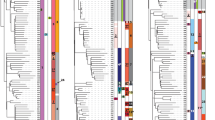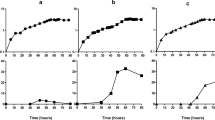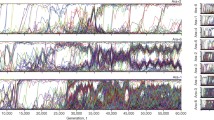Abstract
Molecular evolution was observed through three serial cycles of consecutive random mutagenesis of glutamine synthetase gene and chemostat culture of transformed Escherichia coli cells containing the mutated genes. From an initial of diversified mutant population in each cycle, several varieties of mutants reached the state of coexistence. In addition, a once extinct mutant gene was found to have the capacity to coexist with a gene pool of later cycle of molecular evolution. These results including the kinetic characteristics of the purified wild-type and mutant glutamine synthetases in the phylogenetic tree revealed that the enzyme activity has diverged rather than optimized to a fittest value during the course of evolution. Here, we proposed that the flexibility of the fitness of a gene in consequence to cellular interaction via the environment is an essential mechanism governing molecular evolution....
Access this chapter
Tax calculation will be finalised at checkout
Purchases are for personal use only
Preview
Unable to display preview. Download preview PDF.
Similar content being viewed by others
References
Lenski, R.E., Travisano, M.: Dynamics of adaptation and diversification: A 10,000-generation experiment with bacterial populations. Proc. Natl. Acad. Sci. USA 91, 6808–6814 (1994)
Dykhuizen, D.E., Dean, A.: Enzyme activity and fitness: evolution in solution. TREE, 257–262 (1990)
Fontdevila, A., Mendez, J., Ayala, F.J., McDonald, J.: Maintenance of allozyme polymorphisms in experimental populations of Drosophila. Nature (London) 255, 149–151 (1975)
Ayala, F.: Competition between species: Frequency dependence. Science 171, 820–824 (1971)
Nei, M. (ed.): Molecular Evolutionary Genetics. Columbia University Press, New York (1987)
Helling, R.B., Vargas, C.N., Adams, J.: Evolution of Escherichia coli during growth in a constant environment. Genetics 116, 349–358 (1987)
Xu, W.-Z., Kashiwagi, A., Yomo, T., Urabe, I.: Fate of a mutant emerging at the initial stage of evolution. Res. Popul. Ecol. 38, 231–237 (1996)
Kashiwagi, A., Kanaya, T., Yomo, T., Urabe, I.: How little can the difference be among the competitors at the initial stage of evolution? Res. Popul. Ecol. 40, 223–226 (1998)
Chen, Y.-M., Backman, K., Magasanik, B.: Characterization of a gene, glnL, the product of which is involved in the regulation of nitrogen utilization in Escherichia coli. J. Bacteriol. 150, 214–220 (1982)
Xu, W.-Z., Fukuhara, J., Yamamoto, K., Yomo, T., Urabe, I.: Random mutagenesis of glutamine synthetase from Escherichia coli: Correlation between structure, activity, and fitness. J. Ferment. Bioeng. 77, 252–258 (1994)
Miki, T., Yasukochi, T., Nagatani, H., Furuno, M., Orita, T., Yamada, H., Imito, T., Horiuchi, T.: Construction of a plasmid vector for the regulatable high level expression of eukaryotic genes in Escherichia coli: An application to overproduction of chicken lysozyme. Protein Eng. 1, 327–332 (1987)
Maniatis, T., Fritsch, E.F., Sambrook, J. (eds.): Molecular Cloning: A Laboratory Manual. Cold Spring Harbor Laboratory, Cold Spring Harbor (1982)
Arakawa, T., Jongsareejit, B., Tatsumi, Y., Tanaka, K., Ikeda, K., Komatsubara, H., Inoue, H., Kawakami, B., Oka, M., Emi, S., Yomo, T., Shima, Y., Negoro, S., Urabe, I.: Application of N-terminally truncated DNA polymerase from Thermus thermophilus (Δ Tth polymerase) to DNA sequencing and polymerase chain reactions: Comparative study of Δ Tth and wild-type Tth polymerases. DNA Res. 3, 87–92 (1996)
Lund, P.: UV-method with glutaminase and glutamate dehydrogenase. In: Bergmeyer, H.U., Bergmeyer, J., Grabl, M. (eds.) Methods of Enzymatic Analysis, 3rd edn., pp. 357–363 (1985)
Bidlingmeyer, B.A., Cohe, S.A., Tarvin, T.: Rapid analysis of amino acids using precolumn derivatization. J. Chromatogr. 336, 93–104 (1984)
Cadwell, R.C., Joyce, G.: Randomization of genes by PCR mutagenesis. PCR Methods Applic. 2, 28–33 (1992)
Kimura, M. (ed.): The Neutral Theory of Molecular Evolution. Cambridge University Press, Cambridge (1983)
Yomo, T., Xu, W.-Z., Urabe, I.: Mathematical model allowing the coexistence of closely related competitors at the initial stage of evolution. Res. Popul. Ecol. 38, 239–247 (1996)
Turner, P.E., Souza, V., Lenski, R.: Test of ecological mechanisms promoting the stable coexistence of two bacterial genotypes. Ecology 77, 2119–2129 (1996)
Treves, D.S., Manning, S., Adams, J.: Repeated evolution of an acetate-crossfeeding polymorphism in long-term populations of Escherichia coli. Mol. Biol. Evol. 15, 789–797 (1998)
Hartl, D.L., Dykhuizen, D.E., Dean, A.: Limits of adaptation: the evolution of selective neutrality. Genetics 111, 655–674 (1985)
Author information
Authors and Affiliations
Editor information
Editors and Affiliations
Rights and permissions
Copyright information
© 2004 Springer-Verlag Berlin Heidelberg
About this paper
Cite this paper
Kashiwagi, A., Noumachi, W., Katsuno, M., Alam, M.T., Urabe, I., Yomo, T. (2004). Experimental Molecular Evolution Showing Flexibility of Fitness Leading to Coexistence and Diversification in Biological System. In: Ijspeert, A.J., Murata, M., Wakamiya, N. (eds) Biologically Inspired Approaches to Advanced Information Technology. BioADIT 2004. Lecture Notes in Computer Science, vol 3141. Springer, Berlin, Heidelberg. https://doi.org/10.1007/978-3-540-27835-1_3
Download citation
DOI: https://doi.org/10.1007/978-3-540-27835-1_3
Publisher Name: Springer, Berlin, Heidelberg
Print ISBN: 978-3-540-23339-8
Online ISBN: 978-3-540-27835-1
eBook Packages: Springer Book Archive




